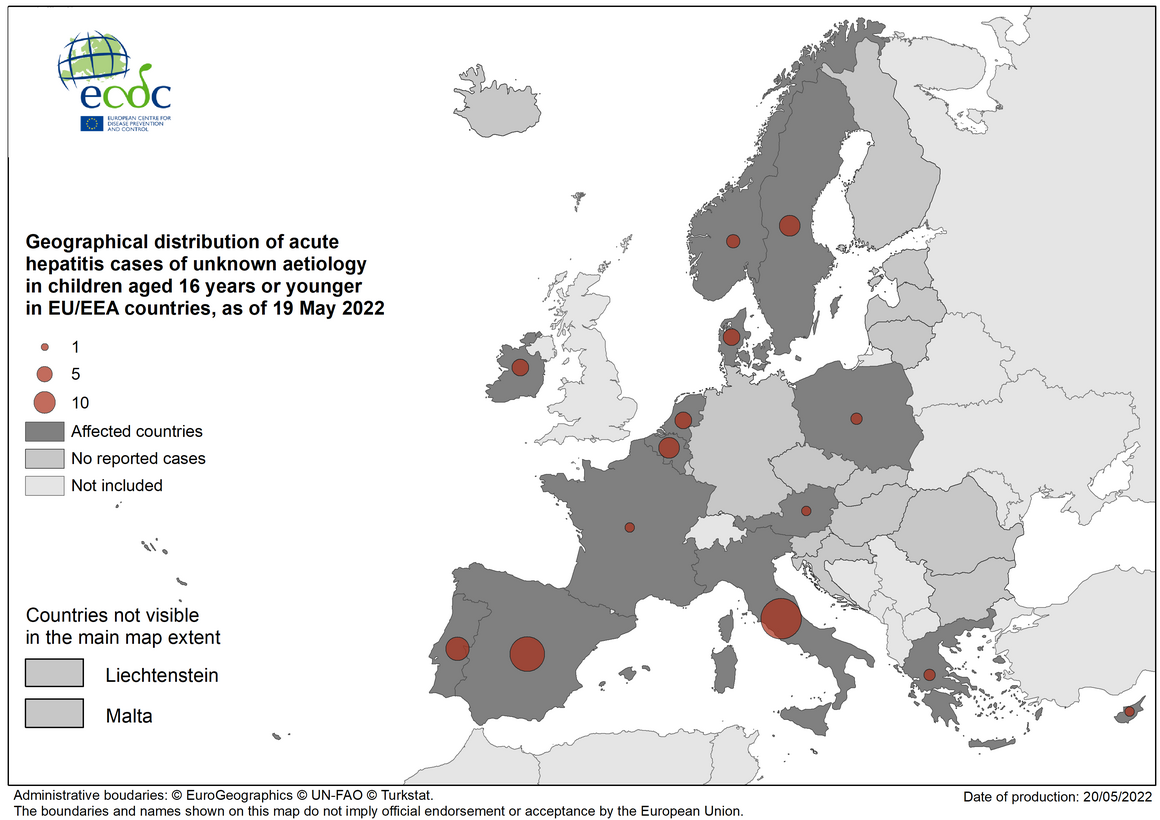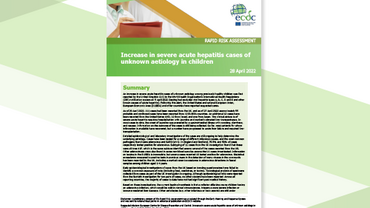Epidemiological update issued 19 May 2022: hepatitis of unknown aetiology in children
Since the last epidemiological update published on 11 May 2022, new cases of hepatitis of unknown aetiology among children aged 16 years and under have been reported worldwide.
The underlying aetiology and disease pathogenesis are still under investigation. A possible association with adenovirus infection has been found in some cases, particularly in the UK, but other hypotheses and possible co-factors are also being investigated. Most cases continue to be reported as sporadic and un-linked.
This report presents an update of cases identified in the European Union/European Economic Area (EU/EEA) and worldwide. Although a common case definition has been established by ECDC in collaboration with WHO and public health authorities in the Member States, the cases presented in this report were collected through epidemic intelligence activities, such as the screening of official websites and media sources and, therefore different case definitions may have been used.
Case definition used in EU/EEA
- Confirmed: N/A
- Probable: a person presenting with an acute hepatitis (non-hepatitis viruses A, B, C, D and E*) with aspartate transaminase (AST) or alanine transaminase (ALT) over 500 IU/L, who is 16 years or younger, since 1 October 2021.
- Epi-linked: a person presenting with an acute hepatitis (non-hepatitis viruses A, B, C, D and E*) of any age who is a close contact of a probable case, since 1 October 2021.
*Cases of hepatitis with known aetiology, such those due to specific infectious diseases, drug toxicity, and metabolic hereditary, or autoimmune disorders, should not be reported under this protocol.
EU/EEA update
In EU/EEA countries, 125 cases have been identified in 14 EU/EEA countries as of 19 May 2022.
Table 1. Number of identified cases by country, EU/EEA, 19 May 2022
|
Country |
Number of cases |
|---|---|
|
Austria |
2 |
|
Belgium |
9 |
|
Cyprus |
2 |
|
Denmark |
6 |
|
France |
2 |
|
Greece |
3 |
|
Ireland |
6 |
|
Italy |
35 |
|
Netherlands |
6 |
|
Norway |
4 |
|
Poland |
3 |
|
Portugal |
12 |
|
Spain |
26 |
|
Sweden |
9 |
|
Total |
125 |
Figure 1. Geographical distribution of cases in EU/EEA, 19 May 2022

Worldwide update
United Kingdom: as of 12 May 2022, the UKHSA has identified a total of 176 children aged under 10 years with acute hepatitis of unknown aetiology. Of these, 11 have received a liver transplant. The most recent technical briefing on investigations into the cases in the UK presents data as of 6 May 2022.
Outside of the EU/EEA and the United Kingdom: 19 May 2022, at least 313 cases of acute hepatitis of unknown origin among children have been reported by 16 countries: Argentina [9], Brazil [44], Canada [11], Costa Rica [2], Indonesia [14], Israel [12], Japan [12], Malaysia [1], Mexico [21], Moldova [1], Palestine [1], Panama [2], Serbia [1], Singapore [1], South Korea [1] and the United States [180].
The total number of cases reported worldwide is 614, including 14 deaths reported from Ireland [1], Indonesia [6], Mexico [1], Palestine* [1] and the United States [5].
*This designation shall not be construed as recognition of a State of Palestine and is without prejudice to the individual positions of the Member States on this issue.
Actions
On 13 May 2022, ECDC published the first Joint ECDC-WHO regional Office for Europe Surveillance Bulletin. On 28 April 2022, ECDC published a rapid risk assessment. ECDC and WHO’s Regional Office for Europe have established reporting of case-based data for cases of acute hepatitis of unknown aetiology in The European Surveillance System (TESSy) for countries in the WHO European Region. The reporting protocol is available here, and countries are strongly encouraged to report cases to TESSy. The first joint ECDC-WHO Regional Office for Europe Surveillance Bulletin based on the data reported in TESSy was published on 13 May 2022. The next surveillance report is planned for 20 May 2022.
An EpiPulse item remains available for Member States to report updates on their investigations in order to inform and facilitate communication between themselves and ECDC. This can include information on common exposures identified, analyses on adenovirus circulation, and any analyses of hospital data to provide information on whether the number of observed cases of hepatitis of unknown origin are in excess of what would normally be expected.
ECDC will continue to monitor this event through surveillance and epidemic intelligence and by communicatig directly with the public health authorities in Member States.
Disclaimer: Data presented in this update are compiled from official national reports or, if not available, from public sources quoting national authorities. Where possible, cases are classified according to the EU/EEA case definition. Media reports might not include complete information on testing, so classification of cases is not always possible. These are presented as ‘cases under investigation’. Data include both probable cases, according to the case definition used in the EU/EEA, and cases under investigation. In some cases, the testing strategy has not been officially confirmed.







